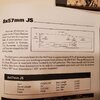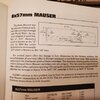The SAAMI spec is for the American "8MM Mauser"--a lower pressure loading with a .323 bullet. There is nothing artificial about it, and it did not result from a change in measurement.
They don't have the problem. They have specs for two different "8MM Mauser" cartridges.
One would not prudently fire European-spec 8X57JS ammunition without knowing that the rifle has a .323 dia. bore.
Well according to the photos I previously posted this thread from the Accurate Manual 2 is in no way congruent with what I see in yourpost. Here's those photos again, and as I said I'll post up similar photos from other reloading manuals, which all list SAAMI as a source of information.
I have a difficult time believing if this information was not factual, SAAMI wouldn't force a revision or retraction of these statements across the decades this information has been published.


I see nothing stating firing cartridges loaded with. 323" diameter bullets in a barrel designed for .318" diameter bullets is smart, nor that a chamber cast would not be prudent in these photos, or in my posts including the one I copied into yours.
I further see nothing supporting load data for 8mm cartridges using .318" diameter bullets nor .323" diameter bullets is restricted to a single continent, and especially with regard to CIP member states, which as I previously noted span 3 continents, so exactly where are you referring to when you use the term "they"? CIP member states are on these continents as I previously posted: Europe, Asia, and South America.
Are you stating no load data for 8mm Mauser cartridges using .318" diameter projectiles exist in the USA? That wouldn't make too much sense as I know of no ban on the importation or manufacture of 8mm Mauser rifles designed to use .318" diameter projectiles in the USA, nor ammunition for those firearms and I have personally seen such firearms offered for sale in the USA on Gunbroker.com and GunsInternatinal.com, and availability of such .318" diameter projectiles in the USA. So I know both exist "here", and lack evidence of load data for either not existing "here". Those for .318" diameter projectiles are noted to lack the "S" following the "J" (or "I") whether here, there, or anywhere. But lack of standardization makes a chamber cast prudent if any question exists, no matter .318" diameter design, .323" diameter design, or anything else questionable such as 25-06 prior to its adoption by Remington in 1969, or the 338-06 in general s it was at one point adopted by A-Square and SAAMI who subsequently folded - as mentioned where any question exists - whether in the USA, Greenland, Africa, etc such an item is located.
What I see actually exists in those photos is exatly what I stated was shown in those photos and I'll type it out specifically here in italics as apparently without including those photos in every post I make referring to the information presented in those photos is construed differently.
"For several years after the change in bore dimensions by the German military, the manufacturers of sporting rifles in Europe continued to use both bore sizes. This causes no confusion to the European users of those cartridges. The American shooting public, however, tends to lump all 8mm cartridges into one category. This fact, plus the importation of older military rifles and some sporting rifles using the smaller dimension bore, has created the potential for damage or injury if the 8X57 "JS" cartridge is fired in an 8X57 "J" firearm.
SAAMI's solution to this problem was to limit the pressures of American manufactured 8mm Mauser ammunition to 35,000 PSI. This low pressure loading allows the safe use of American ammunition in both weapons."
For those who may believe I somehow Photoshopped or otherwise adulterated photos I posted from my hard copy of that manual I purchased from another THR member through the Classifieds, I've run across a pdf copy of the Accurate Manual 2 (for short) recently at this link. And no, I didn't create this website, upload that info, etc.
https://www.google.com/url?sa=t&sou...FjAGegQIBhAB&usg=AOvVaw3kw3mGNxbLEhzFYgOjOSEN
Now if those with inside access at SAAMI can procure documentation from SAAMI that disputes this well published background, please post it up. If those with special access to SAAMI can produce documentation from SAAMI requesting withdrawal of this information from this, or any other manual due to not being factual in any part, please post it up.
ETA: I know of at least one source of both 8X57mmJS factory ammunition as well as 8X57mmJ factory ammunition in the USA, "here" colloquially I suppose in relative terms. Reed's Ammunition and Research in OK.
8X57mmJ Factory Ammunition (which must have used 8X57mmJ load data to manufacture)
https://shop.reedsammo.com/8x57-J-Bore-318_c361.htm
8X57MMJS Factory Ammunition same Factory
https://shop.reedsammo.com/8x57-Mauser_c331.htm
Plus, 8X57mmJR factory ammunition, the rimmed version of 8X57mmJ ammunition
https://shop.reedsammo.com/8x57R-J-Bore-318-Rimmed_c360.htm


